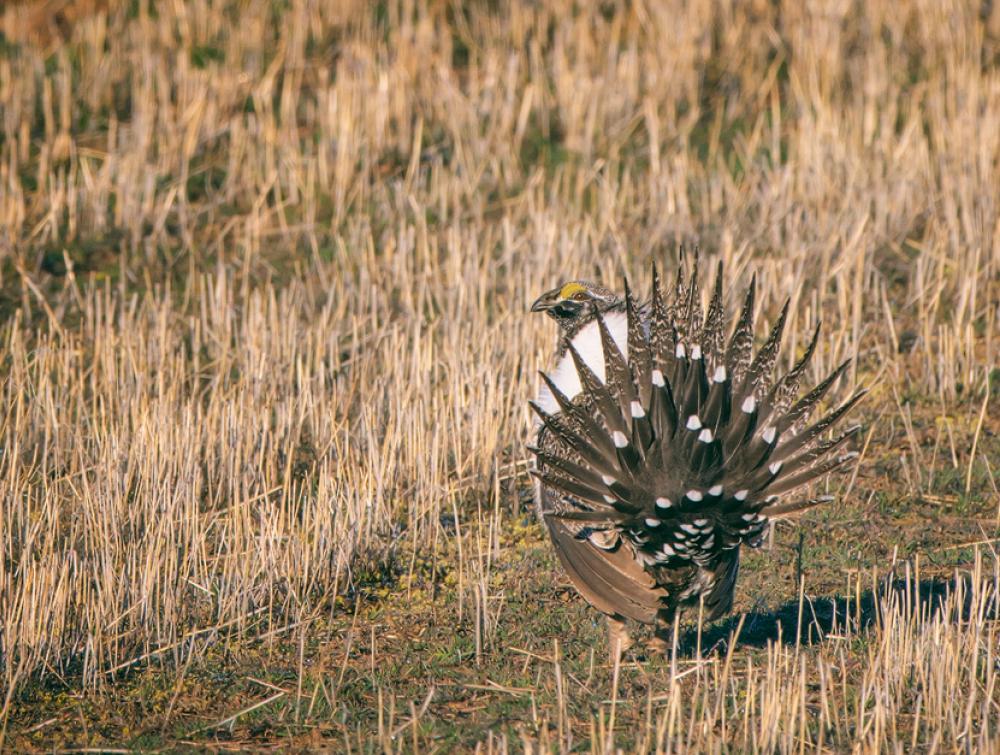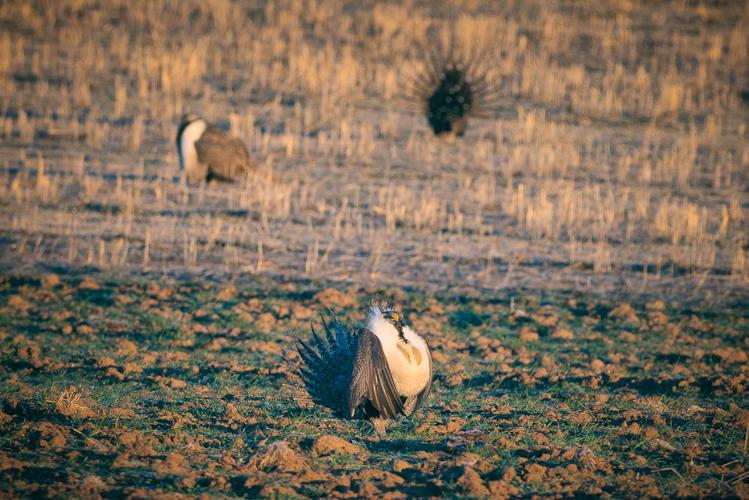Sage-grouse decision conserves far more than sage-grouse

Sage grouse out West.
Mason Cummings, The Wilderness Society
Merging the best science with local knowledge creates win-win plan for 67 million acres of sage-grouse habitat on public lands
September 2016: A year in sage-grouse conservation
The U.S. Forest Service and Bureau of Land Management released their final conservation plans for the vast sagebrush habitat in the American West, a rugged but fragile ecosystem home to some 350 wildlife species.
As America scrambles to stop the decades-long decline in sage-grouse numbers, these plans represent the best chance for rescuing the sage-grouse and keeping it off the list of Endangered Species.
At the same time, the U.S. Fish and Wildlife Service also released its determination that the greater sage-grouse is not facing an imminent threat to extinction that would warrant listing under the Endangered Species Act (ESA). In effect, the agency says that the land management plans in place (federal and state) are enough to keep the sage-grouse from sliding over the brink.
Together, these events create a first-of-its-kind landscape-level conservation effort that knits together local, state and federal perspectives. Some are calling this the largest conservation effort in U.S. history.
This outcome should give Americans across the political spectrum reason to work together to fully implement these commonsense conservation plans to protect the rugged, irreplaceable character of the West.
A long, hard road toward success
Since 1975, sage-grouse habitat has been cut in half, and grouse population numbers have likewise plummeted. In response, several groups filed petitions to list the greater sage-grouse as threatened or endangered under the ESA.
In 2010, the Fish and Wildlife Service determined that sage-grouse warranted ESA protection because of habitat loss and fragmentation, population decline and the absence of conservation strategies. However, the agency also concluded that higher priorities precluded it from taking action.
Environmental groups sued over that inaction, and a court set a firm deadline of Sept. 30, 2015 for the agency to make a decision on the status of the sage-grouse. Today, the BLM and Forest Service finalized plans for habitat they manage. Notably, some 11 western states and private landowners developed plans or made conservation commitments for non-federal lands.
Today, close to the deadline, the Fish and Wildlife Service determined these plans, taken together, have reduced threats across 90 percent the bird’s most important habitat.
Bringing balance back to sage-grouse habitat
More than half of sage-grouse habitat is on federal land managed by the BLM or Forest Service. These agencies have a “multiple use” mandate, including conservation, but also providing for recreation, energy and livestock grazing.
Because of this “multiple use” mandate, agencies look for solutions that find room for all activities. These new plans demonstrate a balanced approach to managing lands for a variety of uses, while still providing for the needs of wildlife.
The strongest protections occur in 35 million acres of priority habitat. Of this priority habitat, about 12 million acres are subject to even stricter protections as sagebrush “focal areas.” The plans also incorporate protections in 32 million acres of “general habitat.” In these lands, damaging activities are to be kept away from habitat hotspots, like grouse mating areas.

Mason Cummings, The Wilderness Society
The plans prohibit “surface disturbing activities” (such as bulldozing new roads) for new oil and gas development. In addition, large-scale wind and solar energy developments are generally prohibited, while transmission lines are to be avoided and subject to other conditions. The plans also require a review of grazing and off-road vehicle use to weigh the impacts on sage-grouse and develop needed management changes. Further, there are limits on the amount of overall surface disturbance permitted by any and all activities taken together in priority habitat.
If poorly planned, energy development poses a significant threat to sage-grouse in the West. Luckily, both independent and agency analyses found relatively little overlap between prime grouse habitat and oil, gas or wind energy resources. The conservation measures put in place can protect the most important grouse habitat while having minimal impact on energy development.
These plans are a significant step on BLM’s path toward true multiple use landscape management—balancing resource development, recreation and America’s natural heritage.
Collaborative conservation that changes the landscape
These plans are powerful because they merge the best available science with the local wisdom of local and state agencies, the region’s conservationists, ranchers, hunters and other interest groups. In fact, these plans broke new ground in large-scale conservation. The Wilderness Society is dedicated to protecting landscapes and finding ways to do so with the input of a wide variety of stakeholders.
“These plans can go beyond the question of listing or not listing under the ESA, incorporating key science and local input to set up an opportunity for conservation across the West,” said Nada Culver, Director and Senior Counsel of The Wilderness Society’s BLM Action Center. “The Wilderness Society wants to continue to contribute leadership to this process and others that transform our public lands into examples of true multiple use management.”
Success will require comprehensive implementation
The work has only begun. The new plans will need to be fully implemented on all levels in order to truly succeed. The federal government will need to work with Western states to ensure conservation measures take root. And the Congress will need provide necessary funding to carry out our commitments to the sage-grouse and future generations of Americans.
The plans recognize that we will continue to learn more and incorporate new information as it is developed. They can be adapted to address future habitat improvements or population gains, as well as indications that more protections are needed due to unforeseen losses.
We can be certain that the sagebrush-steppe ecosystem will face changes in years to come, which will require a solid monitoring protocol and performance reviews. Toward that end, US Fish & Wildlife Service is committed to reevaluate the status of the species in five years and respond to new threats.
The time for planning is behind us. Now it is time for action. The plans are in place. Now its time to make sure they work.
